| | |
Warning: This infobox has missing parameters: subgroup, type and unrecognized parameters: era, members, imageBG
- "Eventually, empires fall like trees—we are the lumberjax!"
- ―Writing on wall of Rebel SpecForce barracks
Alliance Special Forces, also known as the Alliance Special Forces Corp, and better known as SpecForce, were the branch of the Alliance Military that were attached to Alliance High Command.
Specifically selected for high skill, morale, bravery, and dedication to the Rebel cause, SpecForce soldiers were often either from subjugated worlds, or were Imperials disillusioned by the government's tyranny. Rebel forces tended to be more individualistic and ragtag than the forces of the Imperial Military.
SpecForce should not be confused with Special Operations (SpecOps) groups who participated in murky undercover missions that typically involved investigating, snooping and hectic seat-of-the-pants assignments with minimal input from Alliance Command. There was a deep rivalry between the two branches. Although SpecForce members recognized the need for SpecOps, and some considered them capable soldiers, they tended to think of Special Operations agents as amateurs who relied on luck to complete their missions. Likewise SpecOps agents tended to regard their counterparts as a group of arrogant, over-trained grunts with over inflated opinions of their own importance.
Recruitment and training
- "Your candidacy for SpecForce training is itself the mark of a superior soldier."
- ―From the standard acceptance holo to SpecForce candidates
SpecForce training
Very few regular soldiers were capable of becoming SpecForce troopers, and all volunteered for service. Imperial special forces candidates underwent extensive examination to determine political, physical, educational, technical, and mental suitability; they also performed extensive background checks which included interviews of family, friends, and acquaintances to ensure political loyalty. The Alliance did its best to perform background checks, but was limited in its ability to perform interviews of relatives and associates. The SpecForce vetting process was run by Alliance Intelligence and comprised mainly of interviews, interrogations, and examinations. The vetting process was given a high priority, and resulted in the low penetration of the organization by Imperial agents.
The Empire's anti-alien stance gave the Alliance an advantage in creating SpecForce, giving them a large pool of non-Human candidates eager to oppose the New Order. Many of these species possessed abilities particularly suited to covert military operations. In addition, the Empire's oppressive rule caused many Humans to seek service with the Alliance, allowing for a more selective recruitment policy for SpecForce.
SpecForce candidates had already undergone basic and specialist training. When selected for special forces, the troopers would go through another round of advanced training at a drop-camp. The trainees were taught advanced skills essential for special forces service, but the primary purpose of this phase of training was to weed out candidates lacking the drive to succeed in their missions. The standards in every area of training were high, and the drop-out rate was equally high. Many Alliance regular troopers were SpecForce washouts, though there was no stigma attached to such failure. Simply having been accepted onto a special forces training program was a mark of a trooper's superior qualities, and many failed candidates went on to have successful careers within the Alliance military. Basic SpecForce training included two months of weapons drill using blasters, heavy weaponry, hand weapons and slugthrowers.
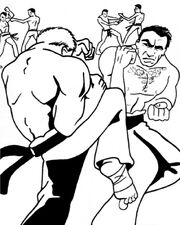
Hand-to-hand combat training.
They also performed numerous deployment scenarios, including stealth drills, overland marches, and para-sail and dropship deployments. The exercises would increase in intensity and difficulty as the trainees progressed through the program, and included live-fire drills and failure-rigged reenactments. This stage of training concluded with a realistic war game scenario, the completion of which meant advancement to a further four weeks of specialization training. In addition to military training, recruits attended lectures on military history.
For specialization training, recruits were sent to another training camp where they would train in a particular area of expertise, depending on their natural attributes and proficiencies. This training built on the specific areas learned in basic SpecForce training, and prepared them for assignment to one of the many specialized regiments within SpecForce divisions.
The identity of SpecForce recruits was a high-level secret. If the enemy discovered their identities, personality profiles to be constructed and/or their friends and family could be targeted. The trainee ID card carried a holoflat, rank, and security clearance only.
SpecForce Trooper
- "The first lesson they taught us in drop camp - basic training for Alliance Special Forces - is that knowing what a weapon can and can't do is important, but the true measure of a soldier does not lie in force of arms. A soldier relies on skill, intelligence and good fortune. A poor soldier relies on a weapon... and weapons can always fail."
- ―Colonel Marck Linth, Alliance SpecForces (5th Regiment).
The SpecForces were the ground troops of the Alliance to Restore the Republic, assigned to fleets to be sent on detached duties to sectors that needed them. Infantry platoons of SpecForces were organized into formal units, much like the Imperial Army, but in the field they were also divided into task forces, consisting of as many soldiers and as much equipment needed to carry out a specific military objective.[1]
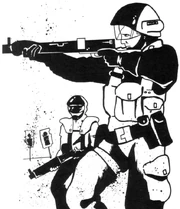
Rebel commando training.
The average SpecForce trooper was a few years older than a regular Rebel soldier, had above average physical and mental abilities and was dedicated to the Alliance and its cause. While they tended to be a little wild in their private lives, when in the field they generally were extremely professional. Like most Alliance soldiers SpecForce troopers were idealistic and committed to the Rebellion against the Empire, although they tended to be even more dedicated. A great number of them were former soldiers from the Empire.
SpecForce troopers were trained to use a variety of tactics, easily adapting to different environments and finding ways to take cover and hold a position in any situation. Hand blasters were standard for every soldier, but some divisions have been known to specialize in particular equipment for some of the more dangerous missions.[1]
SpecForce Officer
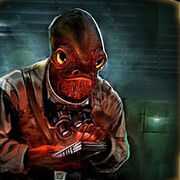
A SpecForce General
A large percentage of the Human SpecForce officers were ex-Imperial military officers who were extensively screened by Alliance Intelligence. They were generally a little younger than regular military officers especially towards the high ranks. The nature of special forces often meant that advancement was faster than regular forces partly because of the higher rate of attrition. SpecForce officers were highly intelligent, creative, and physically fit. They were among the finest military officers in the galaxy during the Rebellion era.
Routine
- "The only thing worse than a fight is waiting for a fight."
- ―Comment overheard on a SpaceOps shuttle in the minutes before a landing assault
SpecForce personnel spent most of their time training, maintaining their equipment, and traveling. The boredom of preparation was punctuated by moments of extreme danger and stress. When SpecForce troopers were called-up for action, their tours of duty tended to be short and exceptionally unpleasant, in contrast to regular tours that were generally longer and carried a lower level of danger. The major difference between regular and SpecForce soldiers was that the latter actively saw trouble more frequently and were expected to function reliably.
SpecForce organization
- "In half an hour I can put together a strike team of twenty soldiers, capable of succeeding at any mission, under any circumstances, anywhere in the galaxy."
- ―General Crix Madine
SpecForce was organized into formal units much like its Imperial counterparts: divisions, regiments, companies, platoons, squads, and fire teams. However, due to scarcity of resources, they rarely operated as full units, instead organizing into taskforces consisting of the appropriate number of soldiers required for a certain mission.
Divisions
Various SpecForce units, from left to right: Guerrilla, Infiltrator, Marine, Officer.
SpecForce consisted of about 10 divisions. One division, Command Division, was under General Crix Madine (via subordinate officers) and was attached to Alliance High Command at all times. It possessed regiments representing all SpecForce specializations, which were assigned to various elements of High Command. Five other divisions were allocated more or less regionally, with the balance deployed as rogue divisions operationally attached to sector commands or other SpecForce divisions as needed. The regionally allocated divisions were commanded by a general; the rogue divisions were theoretically under the command of whatever divisional general they were assigned to, but in practice were primarily commanded by the colonels of their regiments.
Regiments
Regiments were made up of three to six companies (four being the norm), and were commanded by a colonel or, less often, a major. They were consistently numbered within each division by the type of specialist they provided. Like divisions, they were more of an accounting unit than a unit that actually saw action; they provided the pool from which taskforces were assembled. More on regimental specialties are described below.
Companies
Companies usually consisted of five platoons and were commanded by a major or captain, and were identified by aurebesh letters. There were two types: order companies (also order of battle companies or OBCs), consisting of a single specialist type and used for asset tracking rather than actually seeing action; and taskforce companies (TFCs), which were comprised field mission units and were typically composed of two or three platoons of one specialist type, with two or three other platoons of mixed type rounding the unit out and providing operational flexibility. These companies were typically the largest unit to see combat.
Platoons
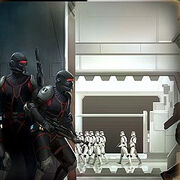
SpecForce Marines on a mission
Platoons consisted of four squads and were commanded by a lieutenant. They were designated numerically.
Squads
Squads consisted of five to fifteen troopers and were commanded by a sergeant. They were designated by color, and were primarily of a particular trooper specialty, though cross-attached elements (usually attached fire teams from other specialties) were common.
A notable squad that fought at the Battle of Hoth was 4th Squad commanded by Corporal Jobin.[2]
Fire Teams
Fire teams consisted of two to five troopers, supervised by a senior trooper (often called first trooper in scandocs). They were the basic tactical element of squad maneuvering, and it was recommended that troopers not act in the field without their fire team members.
Taskforces
Taskforces were the real units which performed SpecForce missions. They could be of nearly any size, though most were company or platoon sized. They were commanded by a taskforce commander (TC), a temporary position given an officer assigned to command a given mission. The TC was not a coveted position, and was given out on the basis of ability; usually, the TC was of a rank appropriate for the size of the taskforce (e.g. a platoon-sized taskforce would typically have a lieutenant as TC). Once selected, the TC would requisition as many appropriately-sized units as were needed for the mission, subject to availability, to comprise the taskforce.
SpecForce Regiments
- "The best advice I can give you is what my drill instructor once told me: 'Weapons are just specialized tools. Only a fool would let a tool do his thinking for him'."
- ―Colonel Marck Linth, Alliance SpecForces (5th Regiment).
As was mentioned, regiments were consistently numbered within each division, with the number indicating the type of specialist they consisted of.
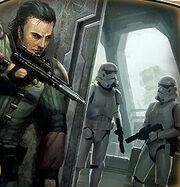
A member of the SpecForce Marines
1st Regiment - SpecForce SpaceOps Regiment
- "Never go into space with someone braver than you."
- ―Conventional SpaceOps wisdom
SpecForce SpaceOps, also called SpecForce Marines or Rebel Marines, were trained primarily for combat onboard ships, though they also had training in zero-g combat, space survival and space-suit operation, having access to the relatively few combat space-suits the Alliance had available. They were the Alliances specialists in boarding and either taking over or destroying enemy vessels. They were also the first line of defense if their ship was boarded. They were trained to identify any weapons in any part of a ship and use those weapons to take out boarders without causing undue damage to the ship.[3] They were armed with blaster pistols, rifles, missile launchers, grenades, and sometimes vibroblades. They had a reputation for having a charge-ahead attitude.
Notable SpaceOps members
- Lieutenant Miko Beski[4][5]
2nd Regiment - SpecForce Pathfinders
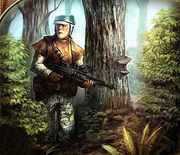
A member of the Pathfinders
- "The easy way is always mined."
- ―Pathfinder observation
SpecForce Pathfinders made clandestine drops into enemy territory, establishing beachheads, performing reconnaissance and holding territory until reinforcements arrived. These sort of operations were typically conducted by a fairly small task force no larger than company size. These task forces were often in great danger since they could easily be annihilated if they were not relieved or extracted before the enemy could mount an effective counter-attack. The secondary role of the pathfinder specialization was to scout for other SpecForce units in ground operations . These missions were also conducted by small units although there was a least backup if something went wrong. Pathfinders were trained for survival, alien species recognition, and repulsorcraft operation. They were normally equipped with blaster rifles, grenades and survival equipment while they often fielded heavy weapons and repulsorcraft for superior mobility. Pathfinder troopers relied on surprise to overwhelm enemy forces.
Notable Pathfinders
- Sergeant Brooks Carlson (Commando, Battle of Endor) [6]
- Lieutenant Mishowan Shigormallan[4]
- Lieutenant Teracca Torrh[7]
3rd Regiment - SpecForce Urban Combat Specialists
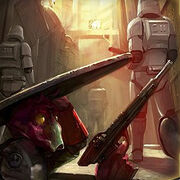
A member of the SpecForce Guerrillas
- "Law of Fortifications: It is always as hard to get out as it is to get in."
- ―UCS to Alliance trooper during the Siege of Kyrska
SpecForce Urban Combat Specialists (or UCS, often simply called Urban Guerrillas) were trained for street combat and were skilled in finding ways to adapt the tough urban fighting environment to suit them. They were also trained in making do with whatever equipment they had and were experts in hand-to-hand combat, street fighting, demolitions and light weaponry. They wore tight yet flexible gray jumpsuits, which partially absorb the shock of blaster bolts and also have visor-helmets.
Notable Urban Combat Specialists
- Oepoono[8]
4th Regiment - SpecForce Wilderness Fighters
- "All-weather equipment fails… usually in bad weather."
- ―Wilderness Fighter observation
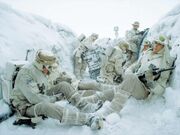
Cold assault wilderness fighters during the Battle of Hoth.
SpecForce Wilderness Fighters, sometimes called Rangers were trained to use their terrain for the best tactical advantage in fighting. They were more mobile than their urban counterparts, and often equipped with A280 and A295 blaster rifles. Since there were so many different terrain types companies specialized for specific combat conditions: arctic, aquatic, jungle/forest, mountain, desert and plains. White-uniformed rangers, trained to work in cold terrain, were present during the Battle of Hoth and stealthy forest-camouflaged rangers struck at the Battle of Endor. The wilderness regiment within a division tended to be spread a little thinner than others. Alliance bases were more than often located in deep wilderness on isolated worlds as far from the Imperial center as possible and therefore wilderness fighters were often assigned to these bases, when not engaged in active operations, to reinforce Sector Force troopers. Wilderness fighters were typically issued with blasters and survival packs. Since they were expected to be more mobile than UCS, wilderness fighters would often use repulsorcraft such as speeder bikes, skiffs and hovertanks. Wilderness regiments were the only SpecForce branch to maintain repulsortank units without the involvement of other trooper specializations. They were trained to use heavy weapons and artillery to reduce their reliance on Heavy Weapons Specialists.
Notable Wilderness Fighters
A fully equipped Infiltrator.
5th Regiment - SpecForce Infiltrators
- "Firepower is no replacement for surprise."
- ―Infiltrator maxim
Rebel Infiltrators were among the most feared of the SpecForce divisions, specially chosen for their distinct hatred of the Empire. They operated as secret agents and spies, trained to slip through enemy lines and sow seeds of rebellion on Imperial worlds or sabotage important installations and ships. Equally comfortable on abduction and rescue missions, infiltrators were trained to use a variety of tactics and weapons. Most stuck to a basic weapon layout to stay light on their feet, but many infiltrators carried sniper rifles and thermal detonators as well. Infiltrators have rarely been seen leaving the scene of the deadly explosion they caused.[1]
Notable Infiltrators
6th Regiment - SpecForce Heavy Weapon Specialists
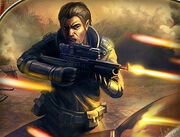
Heavy weapon specialists were often nicknamed "Gunners"
- "Surprise is no replacement for firepower."
- ―Widely held HWS response to an Infiltrator maxim
SpecForces Heavy Weapons Specialists or HWS provided protection against enemy air and ground units and reinforce friendly forces. They were trained in starship gunnery. Though well trained, their casualty rates were high. This is because once an artillery piece's location has been revealed in battle, the enemy tends to desperately try to disable or destroy it. SpecForce Heavy Weapons Specialists were trained to die rather than abandon their guns. Often they were armed with explosives, such as HX2 antipersonnel mines, standard thermal detonators and the HH-15 projectile launcher or missile tubes. When assigned to a taskforce, HWS personnel were commonly called either "gunners" if they specialized in heavy blaster weaponry or vehicle-mounted weapons, or "vanguards" if they specialized in shoulder-fired missile launchers in an anti-mechanized unit role.[11]
Notable Heavy Weapons Specialists
- Sergeant Whumparrin[4]
- Captain Yutani (Commando, Battle of Endor)
7th Regiment - SpecForce Technicians
- "Never forget that your weapon was made by the lowest bidder."
- ―Armorer's admonition to a frustrated trooper
Unlike other regiments, the 7th Regiment was a catch-all unit for miscellaneous specialists. Technically, all members of this regiment were SpecForce Technicians, but the term was usually reserved for mechanics and combat engineers.
SpecForce Drivers and Pilots were trained to pilot vehicles to provide back-up and support for their comrades. They wore unique helmets with dark-tinted visors and dark green jumpsuits. They also carried CR-1 blaster cannons.
SpecForce Scanner-communications Operators (often shortened to "scanners," "scan-com operators," or "eyes") were trained in both sensor operation and communications equipment.
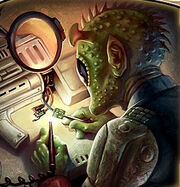
A SpecForce technician
SpecForce Interrogators would acquire information in cases where the Alliance Intelligence interrogators were unavailable because the prisoner in question could not be moved, the information was time-critical, or combat theater danger made using such an interrogator inappropriate.
SpecForce Procurement Specialists (or "scroungers") were personnel adept at acquiring important combat material from unorthodox sources. They were only sent on medium-term or long term missions, and though often deficient in combat skills, their abilities to acquire needed supplies through purchases, loans, requisitions, or outright theft often were critical to missions success.
Notable Technicians
- Corporal Dansra Beezer (Commando, Battle of Endor)[12]
- Corporal Midge (Commando, Battle of Endor)[13]
- Aven Cholus[14]
Special Forces and Special Operations
Though bearing similar names, Special Forces and Alliance Special Operations were two completely different groups. While Special Forces were highly trained active military professionals, tasked with performing specific, carefully planned operations, Special Operations agents engaged in murky undercover missions and chaotic, unplanned operations with only minimal input from Alliance Command. Though SpecForce personnel recognized the need for SpecOps, and vice versa, rivalry between the two groups ran deep; SpecForce personnel viewed SpecOps (or "spooks," as they liked to call them) as amateurs who relied on luck to carry the day, while SpecOps personnel viewed SpecForce as arrogant, uptight, and over trained.
SpecForce sometimes used Mission Group personnel as "other specialists" such as transportation specs, pilots, communication experts, translators, medical technicians, supply specialists, and so on (thus placing them operationally with a division's 7th Regiment). Such personnel were often referred to as "recovering spooks" by the SpecForce units they were attached to.
Conversely, sometimes Special Forces troops were assigned to Special Operations units; these individuals were referred to as "specters" by other SpecForce personnel.
Notable SpecForce units
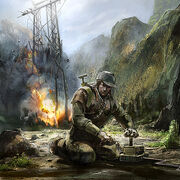
An Alliance demolitions expert destroys an Imperial antenna in Restuss.
- Commando Team One[15]
- Delta Team[14]
- Eclipse Team[16][17]
- Endor Strike Team
- Harrier Infiltration Team[18]
- Katarn Commandos
- Nishr Taskforce[4]
- Outpost Cinder[7]
- Reekeene's Roughnecks[19]
- Renegade Squadron
- Scandium Team[20]
- Taskforce Shen[4]
- Team 19[4]
Notable SpecForce members
- General Crix Madine (Command Division)[4]
- General Brenn Tantor (Command Division - Battle of Endor)[21]
- Major Bren Derlin (Command Division)
- Major Viran Qol[22]
- Major Morgan Q. Raventhorn (Special Operations)
- Lieutenant Ma'w'shiye (Marksman)[17]
- Lieutenant Alfonso Luiz Obota[23]
- Lieutenant Dal Konur[source?]
- Lieutenant Nik Sant (Survival Expert - Commando, Battle of Endor)[24]
- Lieutenant Greeve (Scout - Commando, Battle of Endor)[12]
- Lieutenant Judder Page (Intelligence/Special Operations - Commando, Battle of Endor)[25]
- Lieutenant Mosara Thiirn[16]
- Sergeant Bruckman (Pointman - Commando, Battle of Endor)[24]
- Sergeant Junkin (Demolitions expert - Commando, Battle of Endor)[12]
- Sergeant Squalls (Demolitions expert - Commando, Battle of Endor)[12]
- Corporal Delevar (Medic - Commando, Battle of Endor)[12]
- Corporal Janse (Sharpshooter - Commando, Battle of Endor)
- Corporal Kensaric (Rearguard - Commando, Battle of Endor)[24]
- Kapp Dendo[15]
- Jai Raventhorn[26]
- Orrimaarko[27]
- Spane Covis[28]
- Deena Shan
SpecForce terms and jargon
A SpecForce Infiltrator on the mission.
- Amphibians (also Amphibs, Fish): Aquatic Wilderness Fighters, of which were comprised of amphibian species such as Mon Calamari and Quarren.[4]
- Black-hats (also shadows, shadowmen): Imperial Storm Commandos[4]
- Blaster magnet: SpecForce euphemism for an Imperial officer.[4]
- Cold (also chilly, frosty): A reference to a trooper's ability to maintain calm under fire.[4]
- Commando: A generic term often used by non-SpecForce personnel for SpecForce troopers.[4]
- Cool drop: An insertion into a relatively safe area typically by parasail or para-wing glider.[4]
- Drop (also paradrop): A landing by parasail. Troopers land in the DZ.[4]
- Drop zone (DZ): A pre-selected area where troopers are deployed.[4]
- Field promotion: Rank advancement given to troopers in the combat arena. Also a slang term for killed in action often after participation in a successful mission.[4]
- Ghosts: SpecForce Infiltrators.[4]
- Gunner: Term for SpecForce heavy weapons specialist. A trooper that uses an ISW.[4]
- Hardpoint (also strongpoint): A well-defended target and/or enemy fortification.[4]
- High drop: The deployment of troopers from orbit.[4]
- Hot drop: Landing in a dangerous area typically while under fire or an enemy-patrolled area.[4]
- ISW: Infantry Support Weapon.[4]
- KIA: Killed In Action.[4]
- KSA: Kinky Silver Armor. A term pick up from Special Ops agents referring to Radiation Zone Assault Troopers.[4]
- Landing zone (LZ): Trooper landing area.[4]
- Low drop: Deployment of troopers while in atmosphere.[4]
- Mindspook: A Special Ops agent with enhanced mental capabilities. Often a reference to Force-using agents.[4]
- Mud foot: A derogatory term for inexperienced Alliance infantry.[4]
- Nature lovers: Term for SpecForce Wilderness fighter.[4]
- OBC: Order of Battle Companies.[4]
- Plastic soldiers: Stormtroopers. Also toy soldiers, whitehats and snowmen[4]
- Pop gun: Compressed air slugthrower.[4]
- Puppetmen: Imperial special missions (ISM) troops. The term was derived from their acts of framing "Rebel terrorists" for atrocities.[4]
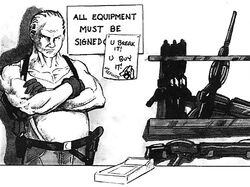
An Alliance Special Forces quartermaster
- Pyroman (also boomer): Demolitions expert.[4]
- Recovering Spook: A mission group agent attached to a SpecForce unit.[4]
- Rocket Jockey: Starfighter pilot.[4]
- Sand Banthas: SpecForce Desert Wilderness Fighters.[4]
- Scanner: Sensor specialist.[4]
- Scanner: Type of sensor.[4]
- Sec: Abbreviation of Sector, as in SecForce.[4]
- SecCom: Sector Command[4]
- SecForce: Sector Force[4]
- Shadowmen: Imperial Storm commandos[4]
- Shadows: Imperial Storm Commandos[4]
- Shadows: SpecForce Infiltrators.[4]
- Shuttling your dead: Refers to the SpecForce policy of recovering the bodies of fallen comrades before leaving an area.[4]
- Smokers: Smoke grenades[4]
- Snowmen: Stormtroopers.[4]
- Spec (also SpecTrooper): Special Forces Trooper.[4]
- SpecCom: Abbreviation of Special Forces Command.[4]
- SpecForce: Abbreviation of Alliance Special Forces.[4]
- SpecTech (also Tech): SpecForces Technician or technical services.[4]
- SpecOps: Alliance Special Operations[4]
- Special: A generic military term for unusual. Also used to describe anything odd or suspicious.[4]
- Special forces: Fighting units trained specifically to undertake particularly difficult missions. Also a branch of the Alliance military.[4]
- SpecTrooper: Alliance Special Forces Trooper.[4]
- Specter: A SpecForce trooper assigned to Special Operations.[4]
- Spook: An Alliance SpecOps Agent.[4]
- Spooky: SpecOps attitude or mission.[4]
- Superspook: Alliance free agent.[4]
- Tauntauns: SpecForce Arctic Wilderness Fighters.[4]
- TC: Task Force Commander[4]
- TFC: Task Force Companies.[4]
- TK: Sniper, from Telekinesis referring to the snipers ability to strike from distance.[4]
- Townies: SpecForce Urban Combat Specialists (UCS).[4]
- Toy soldiers: Stormtroopers.[4]
- TrekSpecs (also Trekker): SpecForce Pathfinders.[4]
- Troopies: Alliance regular soldiers, typically SecForce troopers.[4]
- UCS: SpecForce Urban Combat Specialists.[4]
- Useless: Imperial Officers, especially ranking rear-echelon officers.[4]
- Vacheads: SpecForce SpaceOps trooper.[4]
- Vapebait: SpecForce euphemism for an Imperial officer.
- Whiskers: Accumulated experience, as in "has got long whiskers". Sometimes literal description as SpecTroop human males usually wear beards.[4]
- Whitehats: Stormtroopers.[4]
- Wookiees: SpecForce Forest Wilderness Fighters.[4]
- Wraiths: SpecForce Infiltrators.[4]
Appearances
Sources
Notes and references
- ↑ 1.0 1.1 1.2 Star Wars: Empire at War: Prima Official Game Guide
- ↑ 2.0 2.1 2.2 2.3 2.4 2.5 Entrenched
- ↑ Rebellion Era Campaign Guide
- ↑ 4.00 4.01 4.02 4.03 4.04 4.05 4.06 4.07 4.08 4.09 4.10 4.11 4.12 4.13 4.14 4.15 4.16 4.17 4.18 4.19 4.20 4.21 4.22 4.23 4.24 4.25 4.26 4.27 4.28 4.29 4.30 4.31 4.32 4.33 4.34 4.35 4.36 4.37 4.38 4.39 4.40 4.41 4.42 4.43 4.44 4.45 4.46 4.47 4.48 4.49 4.50 4.51 4.52 4.53 4.54 4.55 4.56 4.57 4.58 4.59 4.60 4.61 4.62 4.63 4.64 4.65 4.66 4.67 4.68 4.69 4.70 4.71 4.72 4.73 4.74 4.75 4.76 4.77 Rules of Engagement: The Rebel SpecForce Handbook
- ↑ Rebel Alliance Sourcebook
- ↑
 Star Wars Customizable Card Game — [[Unknown set: No set defined!]]
Star Wars Customizable Card Game — [[Unknown set: No set defined!]]
- ↑ 7.0 7.1 Hideouts & Strongholds
- ↑ Star Wars Galaxies
- ↑
 "Rebel Jedi" (original article link) on Wizards.com (content now obsolete; backup link)
"Rebel Jedi" (original article link) on Wizards.com (content now obsolete; backup link)
- ↑ Cracken's Rebel Operatives
- ↑
 "The Force Unleashed Preview 3" on Wizards.com (content now obsolete; backup link (/default.asp?x=starwars/article/FUpreview3) not verified!)
"The Force Unleashed Preview 3" on Wizards.com (content now obsolete; backup link (/default.asp?x=starwars/article/FUpreview3) not verified!)
- ↑ 12.0 12.1 12.2 12.3 12.4 Galaxy Guide 5: Return of the Jedi
- ↑
 Star Wars Customizable Card Game — [[Unknown set: No set defined!]]
Star Wars Customizable Card Game — [[Unknown set: No set defined!]]
- ↑ 14.0 14.1
 "Cracken's Rebel Operatives" — Star Wars Adventure Journal 11
"Cracken's Rebel Operatives" — Star Wars Adventure Journal 11
- ↑ 15.0 15.1 Star Wars: X-Wing Rogue Squadron: Battleground: Tatooine
- ↑ 16.0 16.1 Alliance Intelligence Reports
- ↑ 17.0 17.1 Star Wars: Rebellion (video game)
- ↑
 "Uhl Eharl Khoehng" — Star Wars Adventure Journal 8
"Uhl Eharl Khoehng" — Star Wars Adventure Journal 8
- ↑ Stock Ships
- ↑
 "Cracken's Rebel Operatives" — Star Wars Adventure Journal 10
"Cracken's Rebel Operatives" — Star Wars Adventure Journal 10
- ↑ Star Wars: Force Commander
- ↑
 "Imperial Garrisons" — Star Wars Adventure Journal 12
"Imperial Garrisons" — Star Wars Adventure Journal 12
- ↑ Dark Forces: Jedi Knight
- ↑ 24.0 24.1 24.2 Endor Limited
- ↑ The Thrawn Trilogy Sourcebook
- ↑ Gathering Shadows
- ↑ The Essential Guide to Alien Species
- ↑ The Complete Star Wars Encyclopedia
